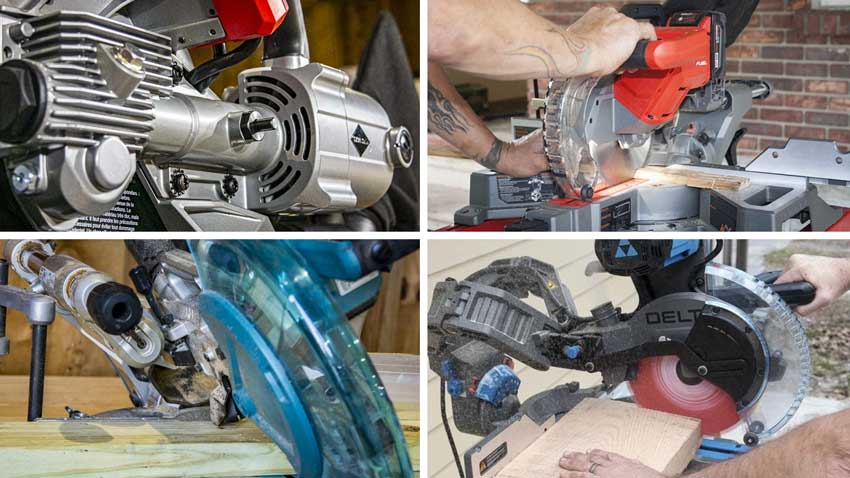If you’re ready to buy a miter saw, do you know which one to choose? With several different types of miter saws available, it’s more than just picking randomly from your favorite brand. We’ll help you decide which type is best for the way you work.
Check out our best miter saw recommendations for the year!
Types of Miter Saws
In its most basic form, the miter saw (sometimes incorrectly called a chop saw) has a table that pivots the blade to the right and left, allowing you to change the angle of the crosscut you’re making. The blade drops straight down, and the blade’s diameter is what limits your cut capacity.
The capacity will be smaller than the blade diameter since the arbor gets in the way of letting it drop all the way through. It may, however, exceed the blade radius when you make a cut against the back of the fence.
Editor’s Note: A chop saw is similar to a miter saw, but with no ability to adjust the miter angle from 90 degrees. Most chop saws are designed to cut metal. Some people refer to a miter saw as a “chop saw” but we separate them. Check out our chop saw vs miter saw article for more on that topic.
Sliding Miter Saw
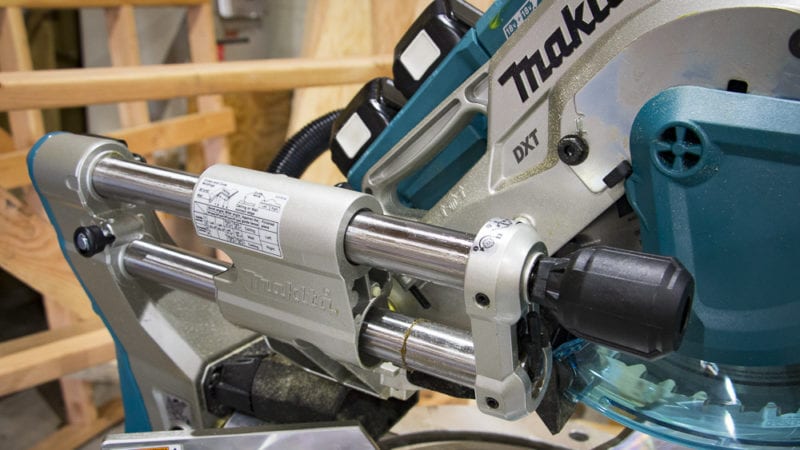
A sliding miter saw is a type of miter saw that uses rails so the saw blade can slide front to back across the wood. It gives you a much greater cutting length than the same size miter saw without rails. For example, a non-sliding miter saw might only have the capacity to cut 2 x 6 lumber, while a sliding miter saw with the same size blade can cut 2 x 12 lumber.
Compound Miter Saw
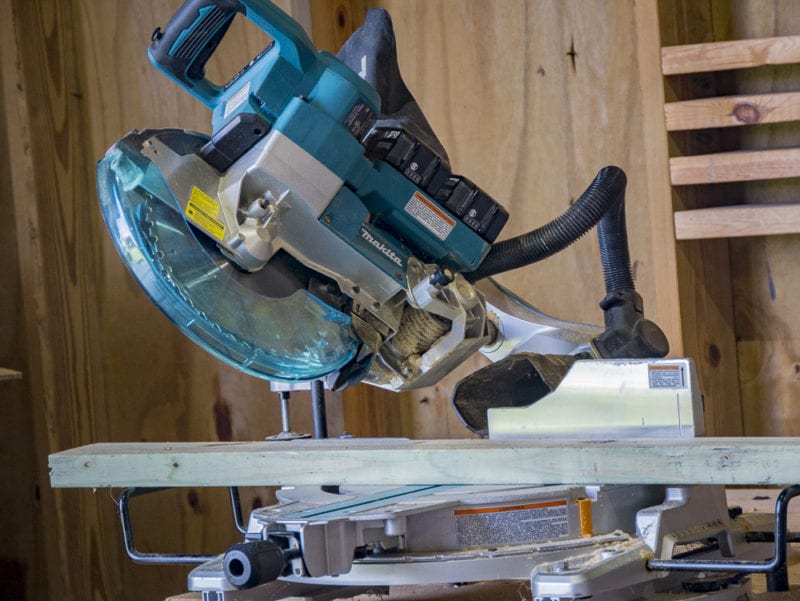
Compound cuts include both beveling (tilting) and mitering (rotating) the saw blade. A compound miter saw has the ability to make both actions simultaneously. You’ll want to make sure you have this feature anytime you work with crown molding or other trim that gets installed on a wall.
Compound Sliding Miter Saw
The compound sliding miter saw includes the best of both worlds. This miter saw uses rails to increase the crosscut capacity and has a bevel function to make compound cuts. In this way, you get the flexibility of a compound miter saw with the added depth of cut afforded by the slide.
Dual-Bevel Compound Sliding Miter Saw
A dual-bevel compound sliding miter saw has a mitering function, sliding rails, and beveling that tilts both left and right. The left bevel eliminates the need to flip your material around to make opposite compound cuts and is far more convenient.
This design saves you some time and frustration. If you prefer to make your crown and base molding cuts flat on the table instead of tall against the back fence, a dual-bevel compound miter saw avoids a lot of hassle on longer pieces of material.
What Size Miter Saw Should You Buy?
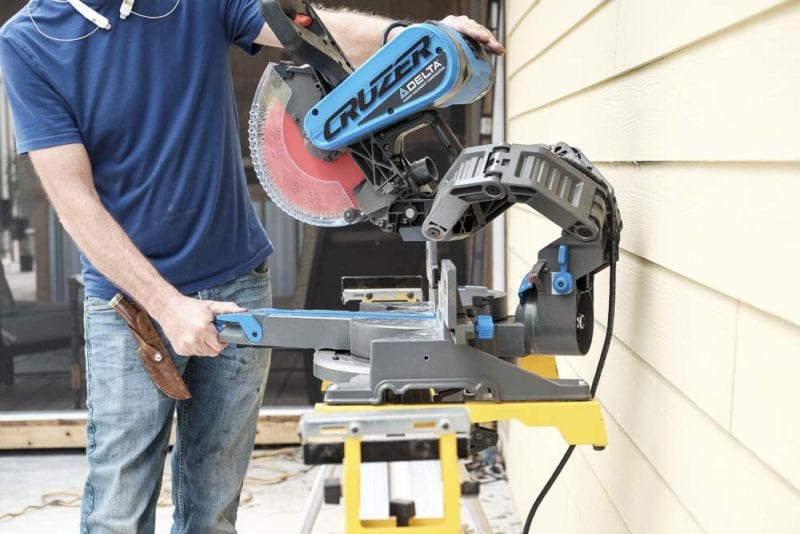
When considering the various types of miter saws, focus on the nature of your work and the material you intend to cut. From there, understand the trade-offs between capacity versus portability. If you rarely need to cut to the capacity of a 12-inch sliding compound miter saw, why carry the extra weight?
Often, a compact 8 1/2-inch sliding model has the capacity you need for 85% of jobs or more. After all, a miter saw is primarily a tool for trim work. You can more easily make most cuts on 2x lumber (or thicker lumber) with a circular saw.
If you need capacity for vertical base and crown cuts, a 10-inch or 12-inch saw makes sense. However, if most of your cuts are flat on the base, then a sliding 8 1/2-inch saw often makes more sense. It’s more portable and can save you a lot of hassle day in and day out.
That said, compact miter saws have less powerful motors. Carpenters and woodworkers who frequently work with expensive hardwoods may benefit from the higher power of 10- and 12-inch miter saws, even if they don’t need the capacity.
- Buy a 12-inch miter saw if… you need to cut wider material like 2 x 12, and you don’t mind a larger saw. This saw also works best if you plan to use a stand or you’re attaching it to a bench. Cutting vertical crown tall also often requires this size saw.
- Buy a 10-inch miter saw if… you want high capacity with a lighter weight and slightly smaller build.
- Buy a compact miter saw if… you prioritize portability and plan to cut smaller base, crown, and door trim.
Traditional Rails vs “Glide” and Fixed Rail Mechanisms
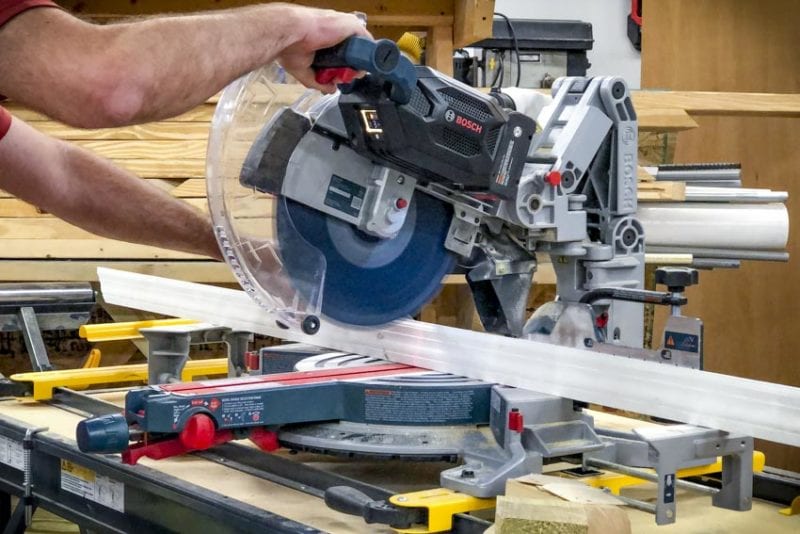
Another consideration when deciding which type of miter saw to buy concerns where you intend to use it. A traditional sliding miter saw requires room behind the saw for the rail system to slide back. If you want to save space, some saws have innovative designs that don’t require rear clearance for the rails.
The Bosch Axial Glide miter saw uses a mechanism that creates a sliding motion without requiring rails at all. The Delta Cruzer miter saw works in a similar manner. The system is so effective and smooth that we’ve used Bosch’s Axial Glide models as our primary miter saws for more than a decade.
If the Axial Glide design isn’t for you (or you want a less expensive option), look for a miter saw with fixed rails. Instead of sliding with the head, the rails don’t move at all, so they don’t extend behind the saw when you make a cut.
Should You Buy a Corded or Cordless Miter Saw?
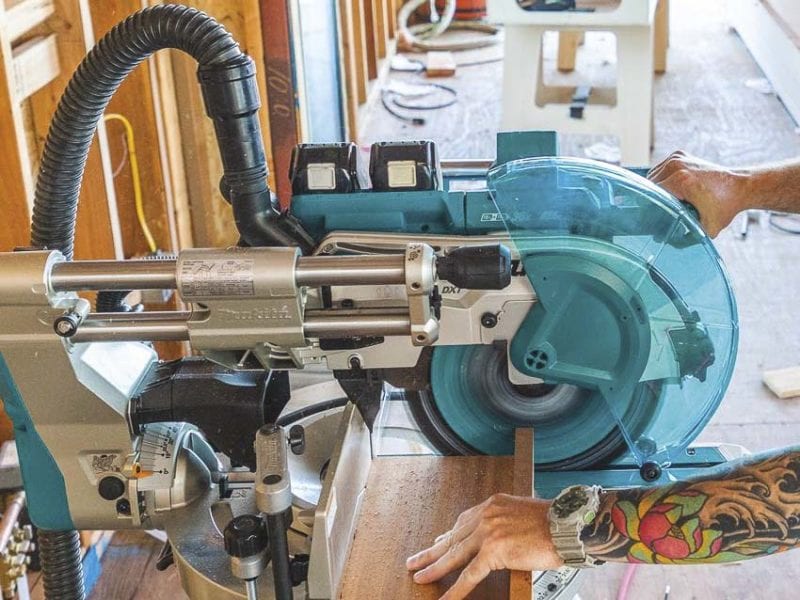
The question of whether you should buy a corded or cordless miter saw didn’t even exist 10 years ago. Now, some of the best miter saws we use have versions that run on battery power.
The top cordless miter saws on the market easily match the performance of their 15-amp corded counterparts. Many of those cordless models are just as feature-rich as well, reducing the number of deciding factors.
The main trade-offs for gaining cordless convenience are runtime and price. You’ll need to have enough battery capacity to get you through the day. That could mean having one or two high-capacity batteries ready to go, or cycling smaller batteries on a charger.
Either way, cordless miter saws are more expensive. The bare tool might be close to the same price as the corded version, but batteries and chargers increase the price. Plus, you eventually have to replace batteries (usually every 3 – 5 years).
There are a few hybrid options available if you want to have the option of running either corded or cordless. Metabo HPT’s 36V miter saws and Flex’s 24V miter saw have optional AC adapters you can buy to give you the greatest versatility. DeWalt’s original FlexVolt miter saw also had AC capability, but that model has been discontinued.
Final Thoughts
While shopping for a miter saw may seem intimidating at first due to the sheer number of options, it doesn’t have to be complicated. It all depends on what you’re planning on using it for the most. There’s a miter saw out there for every workbench and jobsite, no matter your space, application, or experience.
Related Content
